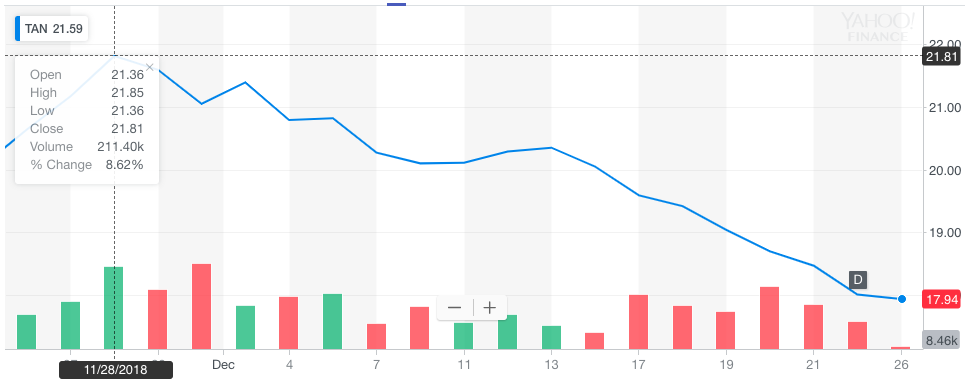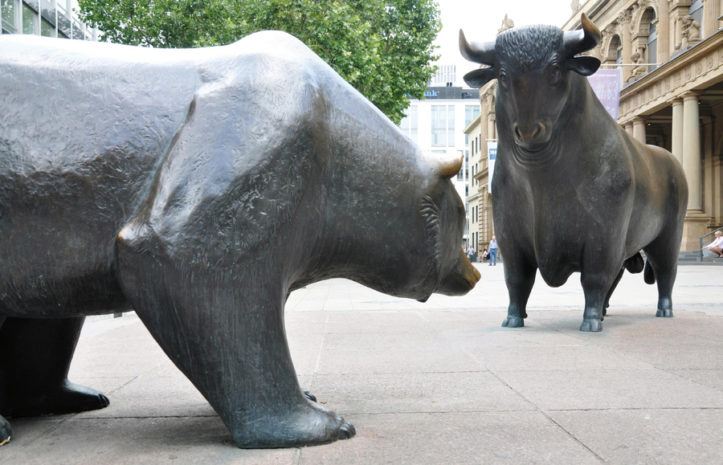December has not been a pretty month for the U.S. stock market. After years of continued rising values, the S&P 500 is on track to fall 14.8% over the month December. This would mark its worst December since the nadir of the Great Depression in 1931.
Solar has not been spared in the carnage. On Christmas Eve the Invesco Solar ETF (NASDAQ: TAN) closed at 18.01 per share, a 17% fall since it peaked at $21.85 in late November. Individual stocks fared worse. Tesla (NASDAQ: TSLA) has taken a hammering, falling to 22% from December 13 to 24th, but even worse came for JinkoSolar (NYSE: JKS), Sunrun (NASDAQ: RUN) and SunPower (NASDAQ: SPWR), all of which fell at least 25% from December 12-13 to their close on the 24th.

However, while the market crash over the last two weeks has been unprecedented for the last decade, for solar this is not that unusual. TAN saw similar falls in October of this year, as well as in late May/early June and the end of January through early February. And each time the exchange traded fund (ETF), which carries many of the big names in solar, has rallied.
JKS’ fall in the last two weeks is only one of many the stock has seen, losing nearly 2/3 its value since a peak last November, and SPWR’s decline is not nearly as bad as it saw in the first three quarters of 2016. As for Tesla, its stock was all over the map even before Elon Musk’s $40 million tweet in August. And while TSLA has fallen and rallied in quick succession, it has stayed above $250 per share since January of last year.
And not every stock has suffered. Hanwha Q Cells (NASDAQ: HQCL), which is poised to become the 2nd-largest solar module maker in the Western Hemisphere when its Georgia factory comes online, has shown no sign that is was affected by the market slowdown – despite the spread of the collapse to Asian markets.
It is unclear how the end of the month will play out. The S&P 500 was showing signs of rallying this morning, but it is not clear yet whether this is a “dead cat bounce”, or a real recovery. Many observers are citing the government shutdown and uncertainty in the federal government due the unconventional and seeming erratic behavior of President Trump, but Bloomberg also notes that the dip is in contrast to generally strong macroeconomic signals.
And for those in solar PV, this may be just another ride on the solar coaster. It is also definitely not yet the worst fall to date for solar, as anyone who remembers the decimation in 2011 will attest to. During a nine-month period in 2011, TAN lost 70% of its value – after losing 3/4 of its value over a 5-month period during the last market collapse in late 2008.

This content is protected by copyright and may not be reused. If you want to cooperate with us and would like to reuse some of our content, please contact: editors@pv-magazine.com.









By submitting this form you agree to pv magazine using your data for the purposes of publishing your comment.
Your personal data will only be disclosed or otherwise transmitted to third parties for the purposes of spam filtering or if this is necessary for technical maintenance of the website. Any other transfer to third parties will not take place unless this is justified on the basis of applicable data protection regulations or if pv magazine is legally obliged to do so.
You may revoke this consent at any time with effect for the future, in which case your personal data will be deleted immediately. Otherwise, your data will be deleted if pv magazine has processed your request or the purpose of data storage is fulfilled.
Further information on data privacy can be found in our Data Protection Policy.